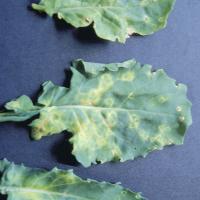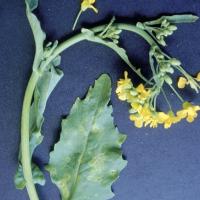Diagnosing cauliflower mosaic virus in canola
An aphid borne viral disease in canola that has the potential to cause significant yield loss with early infection, but rarely occurs in WA.
What to look for
- Pale, sometimes stunted plants that occur in patches, in thinner crop areas or the edge of the paddock, and gradually spread.
Paddock
- Older leaves have pale ring-spots or are mildly mottled with pale veins.
- Plants infected before stem elongation can be stunted, with few flowers or seeds.
Plant
Where did it come from?
- Cauliflower mosaic virus (CaMV) is not seed-borne and does not infect non-brassica crops. It survives in wild radish weeds or volunteer canola host plants outside the growing season and is spread from these infected plants into crops by aphids which act as vectors for virus transmission.
- Brassicaceae weed hosts include wild radish and turnip weed.
- Brassicaceae crop hosts include canola, mustard, cauliflower, broccoli and cabbage.
- CaMV is non-persistent, and is transmitted by many aphid species including green peach and cabbage aphids. The virus is retained in the aphid mouth parts for short periods and lost when the infective aphid feeds on healthy plants.
- Autumn is the most critical infection period, so the earliest-sown crops are usually infected most.
- Infections can occur past the rosette stage of canola growth but these probably have little effect on yield.
Management strategies

Grass weed control

Stubble management
- The disease is rare and does not warrant treatment. Treatments are:
- Control brassicaceous weeds and volunteer canola (especially over summer) as they act as reservoirs for the viruses.
- Retain stubble at sowing to cover the ground, this reduces the ability of aphids to land on young canola plants thereby reducing virus spread.
- Manipulate sowing dates: Delay sowing to avoid exposure of young canola seedlings to peak aphid flights.
- Sow at high seeding rates: High plant density helps diminish the rate of virus spread and speeds up canopy closure resulting in lower aphid landing rates.
See also
Where to go for expert help
Page last updated: Thursday, 16 April 2015 - 1:19pm



